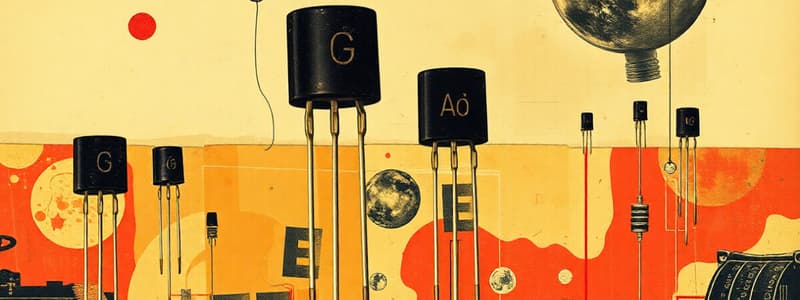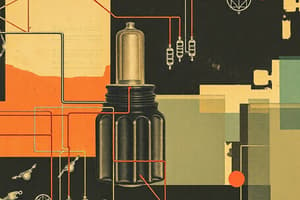Podcast
Questions and Answers
What is the primary function of a resistor in an electrical circuit?
What is the primary function of a resistor in an electrical circuit?
- To generate electrical current.
- To amplify the voltage.
- To restrict the flow of electrical current. (correct)
- To store electrical charge.
Which of the following components is commonly used in dimmer switches and volume controls?
Which of the following components is commonly used in dimmer switches and volume controls?
- Light Dependent Resistor (LDR)
- Fixed resistor
- Thermistor
- Variable resistor (correct)
How does the resistance of a thermistor change as its temperature increases?
How does the resistance of a thermistor change as its temperature increases?
- The resistance remains constant.
- The resistance fluctuates randomly.
- The resistance increases.
- The resistance decreases. (correct)
In what application would an LDR (Light Dependent Resistor) be most suitable?
In what application would an LDR (Light Dependent Resistor) be most suitable?
What is the primary function of a diode in an electrical circuit?
What is the primary function of a diode in an electrical circuit?
A circuit contains a thermistor and an LDR. If both the temperature and light intensity increase simultaneously, what combined effect will this have on the circuit's overall resistance?
A circuit contains a thermistor and an LDR. If both the temperature and light intensity increase simultaneously, what combined effect will this have on the circuit's overall resistance?
Consider a circuit with a fixed resistor and a variable resistor connected in series. If the variable resistor's resistance is increased, what happens to the current flowing through the fixed resistor?
Consider a circuit with a fixed resistor and a variable resistor connected in series. If the variable resistor's resistance is increased, what happens to the current flowing through the fixed resistor?
Imagine a complex circuit that includes a thermistor, an LDR, and a diode, all connected in series with a fixed resistor and a power source providing alternating current. Under very high temperature and intense light conditions, what will be the most likely behavior of the circuit?
Imagine a complex circuit that includes a thermistor, an LDR, and a diode, all connected in series with a fixed resistor and a power source providing alternating current. Under very high temperature and intense light conditions, what will be the most likely behavior of the circuit?
Flashcards
Electrical component
Electrical component
A device in an electric circuit, such as a battery, switch, or lamp.
Electrical current
Electrical current
Moving electric charges, such as electrons moving through a metal wire.
Filament
Filament
A thin wire that heats up and glows when current flows through it, emitting light.
Resistance
Resistance
Signup and view all the flashcards
Fixed resistor
Fixed resistor
Signup and view all the flashcards
Variable resistor
Variable resistor
Signup and view all the flashcards
Thermistor
Thermistor
Signup and view all the flashcards
LDR (Light Dependent Resistor)
LDR (Light Dependent Resistor)
Signup and view all the flashcards
Study Notes
- Electrical circuits contain various components represented by specific symbols.
- A switch controls the circuit, turning it on when closed and off when open.
- In a bulb, electrical current heats the filament, causing it to emit light.
- A resistor limits the flow of electrical current.
Types of Resistors
- A fixed resistor has a constant resistance value.
- A variable resistor's resistance can be changed, as found in dimmer switches and volume controls.
- A thermistor's resistance changes with temperature; high resistance at low temperatures, decreasing as temperature increases, useful in thermostats and fire alarms.
- A light-dependent resistor (LDR) changes resistance with light intensity; high resistance in low light, decreasing as light increases, used in cameras and automatic lights
Diodes
- A semiconductor diode allows current flow in only one direction.
- Diodes convert alternating current (AC) into direct current (DC).
Studying That Suits You
Use AI to generate personalized quizzes and flashcards to suit your learning preferences.
Description
Explore electrical circuit components. Learn about the symbols, how resistors limit current flow, and how diodes control current direction. Understand fixed, variable, and light dependent resistor.




